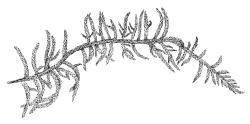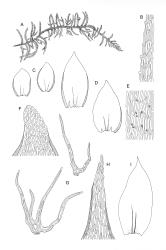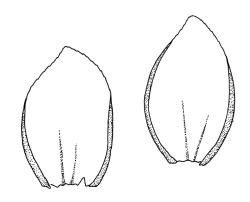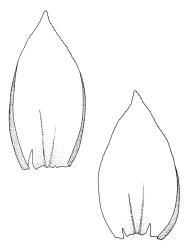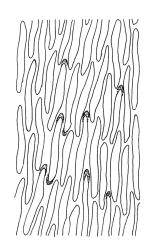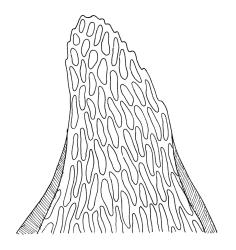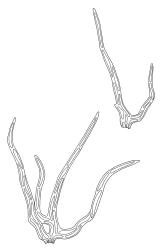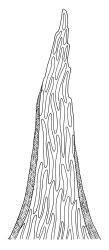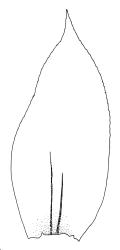- ≡ Hypnum splendens Hedw., Sp. Musc. Frond. 262 (1801)
Plants medium-sized, yellow- to olive-green, mostly dull or faintly lustrous, forming loose wefts. Stems prostrate or ascendant and self-supporting, wiry, red-brown, densely beset with filamentous paraphyllia, commonly 60–120 mm long in N.Z. material, irregularly subpinnate (in N.Z. material), often with scarcely-branched horizontal stolons, in cross-section with several layers of thick-walled cortical cells surrounding a medulla of prosenchymatous cells, lacking a central strand; rhizoids lacking (or infrequent fide Rohrer); branches densely spaced on stems, short, c. 10 mm, simple or branched, distinctly curved (especially near tips), tapered apically and when dry sometimes appearing weakly cuspidate. Stem and branch leaves differentiated. Stem leaves erect and overlapping, oblong-ovate, abruptly narrowed to a short and ± channelled acumen (in N.Z. material), concave, smooth when moist, ± striolate when dry, slightly narrowed and not clasping at base, c. 1.5–1.8 × 0.8–1.1 mm, c. 2:1; margins narrowly reflexed near base, plane above, often pinched at the base of the acumen, distantly serrulate or crenulate below, distinctly serrulate at acumen; mid laminal cells vermicular, strongly prorate, variably porose, 30–45(–54) × c. 5 µm and 10–13:1, becoming longer and more distinctly porose towards leaf base; cells at insertion orange-brown, incrassate, strongly porose, forming a pigmented band across the leaf base; alar cells not differentiated or slightly wider than adjacent basal cells. Costae double, often ± pigmented, extending ¼–½ the leaf length. Branch leaves much smaller, ± elliptic, distinctly narrowed to base, abruptly narrowed to a broad and obtuse apex, c. 0.8–1.0 mm on well-developed primary branches (smaller near branch tips or on secondary branches). Costae shorter and sometimes ± absent. Paraphyllia abundant on stems and branches, much-branched and filamentous. Pseudoparaphyllia not seen.
Dioicous. Perichaetia scattered on stems, the leaves ovate-lanceolate, spreading at tips, ecostate, c. 1.5 mm. Perigonia and sporophytes unknown in N.Z.
Crum & Anderson 1981, fig. 608; Rohrer 1985, fig. 1 a–g, fig. 2a; Noguchi 1987–1994, fig. 531; Smith 2004, fig. 315. The illustration in Sainsbury (1955, pl. 76, fig. 2) gives an inaccurate impression of this species.
The morphology of N.Z. material differs markedly from representative northern hemisphere specimens of this species. Our high-elevation material (above c. 1300 m) does not develop the successive annual stem innovations that give most northern hemisphere material a distinctive layered appearance. By contrast, nearly all N.Z. material is subpinnately branched, has broad branch leaf apices, and a bright red stem when fresh. N.Z. material also lacks rugose stem leaf apices and has broader branch leaf apices than the species does in North America (cf. Crum & Anderson 1981). These distinctions led Macmillan (1994) to refer to N.Z. material as "Hylocomium aff. splendens".
The combination of the densely and subpinnately branched plants, abundant paraphyllia, distinctly curved branches, and dimorphic leaves with double costae and prorate laminal cells make confusion with any other N.Z. species unlikely. Macmillan (1994) aptly described it as growing in "loose, flat patches" with straw-coloured leaves and red stems which give "an underlying pinkish glow to the patch". In habit this species can appear somewhat like a diminutive Pseudoscleropodium purum, but the similarity is superficial, and the two are unlikely to be confused.
NI: Gisborne (Mt Hikurangi), Hawke’s Bay (Mt Kaweka, Ruahine Range), Wellington (Mt Ruapehu, Kaimanawa Range, Ōhutu Ridge, Tararua Range). The record from the Kaimanawa Range is based on a sight record from Matt Renner (pers. comm. 18 Jan. 2010).
Bipolar and probably indigenous in N.Z. Widespread in the northern hemisphere.
This species is documented from North I. high-altitude and wind-swept locations, where it can be fairly common locally (as at Armstrong Saddle and "north of Tūpari", both in the northern Ruahine Range). Its apparent absence from South I. is remarkable. Well-documented specimens from "north of Tūpari" (D. Glenny 4843, 4849, & 4851, WELT) grew on soil "through Dracophyllum recurvum" or were associated with Podocarpus nivalis in a tussock shrubland with Chionochloa pallens. Associated cryptogams recorded by Glenny included: Racomitrium sp. (likely R. pruinosum), Cladia aggregata, Breutelia pendula, Polytrichum commune, Bartramia papillata, Ptychomnion densifolium, and Dicranoloma sp. (likely D. robustum). A very similar range of associates (with the addition of Hymenophyllum multifidum, Celmisia incana, and C. spectabilis) was recorded from a site at 1405 m near Armstrong Saddle in the Ruahine Range (A.J. Fife & H. Baynes 13064, CHR 632040). Although there are several post-1932 collections (in CHR, all poorly localised) from the Tararua Range, there appear to be no recent collections from there.
Hylocomium splendens also occurs below tree-line. At the Ōhutu Ridge in the NW Ruahine Range, Macmillan (1994) found this species to be "locally common" in bogs, boggy stream beds, and clearings associated with Libocedrus bidwillii forest; one of her collections (B.H. Macmillan 92/24, CHR 482382) was made "on top of [a] limestone slab". Macmillan (1994) recorded Hypnum cupressiforme and Drepanocladus aduncus as associates in a "boggy stream bed". This species also occurs in mountain beech forest on the Sunrise Track (Ruahine Range) where it was gathered from "stony ground, with Ptychomnion aciculare, Dicranoloma robustum" (L.H. Cave 933, CHR 611358). Ranging from c. 1200 m (Ōhutu Ridge and near Sunrise Hut) to c. 1900 m (Upper Makatote River on Mt Ruapehu).
No other member of the Hylocomiaceae (or its closely allied families) occurs naturally in the southern hemisphere. The first N.Z. collection of Hylocomium splendens was made by L.B. Moore in March 1932 on Mt Hikurangi. Only female sex organs have been seen in N.Z. material; these organs are often difficult to locate because of the close spacing of the branches on the stem. Sporophytes are unknown here and rare in other parts of the species’ range. The exclusively northern hemisphere distribution of its relatives, the lack of early N.Z. collections, and the unisexual nature of N.Z. populations suggest that this species could possibly be adventive here. Paradoxically, this species appears to be fully integrated into undisturbed vegetation and not to be associated with known adventive species at Armstrong Saddle. Herbarium records also suggest that H. splendens occurs in N.Z. only in undisturbed vegetation. The true status of this species in the N.Z. flora cannot be resolved with our present level of knowledge; it is best considered indigenous until further evidence can be brought to bear on the question.
Hylocomium splendens is one of the most abundant terrestrial species in the boreal coniferous forests of the northern hemisphere. In North America it is sometimes termed the "stair-step moss" (Crum & Anderson 1981), because of its production of characteristic annual layers of horizontal branches lying in a single plane.
Material similar to the usual N.Z. subpinnate expression of H. splendens occurs in arctic tundra and similarly exposed sites in northern parts of the northern hemisphere. These forms have been given taxonomic recognition under the names Hylocomium alaskanum (Lesq. & James) Aust. and H. splendens var. obtusifolium (Geh.) Paris. Steere (1978) considered H. alaskanum "only a stunted physiological-ecological tundra form or ecotype of Hylocomium splendens which does not merit nomenclatural recognition at any taxonomic level". Steere’s conclusions are echoed by Crum & Anderson (1981, p. 1225). Steere’s conclusions regarding northern hemisphere material apply equally to N.Z. populations.
Material collected from below tree-line (e.g., collections from the Ōhutu Ridge by B.H. Macmillan, including CHR 482378, 482420 et al.; A. Knight s.n., from near Sunrise Hut, Ruahine Range, CHR 632086) exhibits a slight tendency towards bipinnate branching and for the branches to be crowded on portions of the stem.



